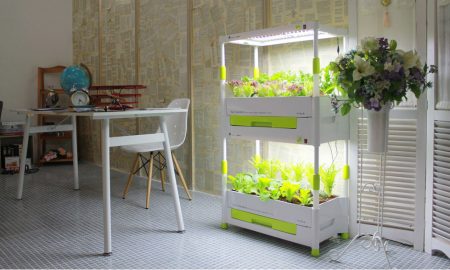 In the autumn-winter season, during a period of particular lack of sunlight and daylight, there is a need for home lighting seedlings. In this article, just in time, we will talk about lighting for seedlings at home with their own hands. It immediately raises a huge number of questions: how to produce lighting, with which lamps, etc. During the growth, all plants direct the color, often spending all their energy towards the sun, the result is a thin stalk and leaves only at the top of the stem, the disease of the "black leg", death.
In the autumn-winter season, during a period of particular lack of sunlight and daylight, there is a need for home lighting seedlings. In this article, just in time, we will talk about lighting for seedlings at home with their own hands. It immediately raises a huge number of questions: how to produce lighting, with which lamps, etc. During the growth, all plants direct the color, often spending all their energy towards the sun, the result is a thin stalk and leaves only at the top of the stem, the disease of the "black leg", death.
A favorable time for planting seeds in order to obtain seedlings is the last months of winter. The winter months can not boast of an abundance of sunny days, so you can not do without home lighting. And it’s not so difficult to build it yourself, because it’s not troublesome and inexpensive. However, the result will be positively positive.
The first option that you might immediately think about is an ordinary light bulb, but it is not suitable for highlighting seeds, since the power of such lamps is too high. The heat generated by the incandescent lamp will be too much and can lead to burns. However, at the same time they have minimal light output, this will not be enough light for plants. The range of such lamps is blue, it is absent in such lamps. Do not try to buy lamps with a lot of watts - this option is not suitable for highlighting seedlings. Certain classes like diffused light, which is important, for example, when growing avocado.
So how to make lighting for seedlings at home (photo)? To illuminate plants at the germination stage, several lamp options are possible. First you need to figure out how to choose a lamp, and what kind of lighting should be. Naturally, it’s quite difficult to replace ordinary daylight and sunlight. But both of them have physical characteristics - your task is to repeat them by choosing the right kind of lighting, thereby “tricking” the plant.
Sunlight is a spectrum - waves of different lengths of hydrogen, helium and ionized metals - consisting of parts visible and not visible to the eye. Plants must receive the full spectrum for proper development. Each of the waves brings its own benefit, in its own way accepted by the seedling.
The spectrum consists of seven colors - it is very important to know to create artificial lighting for seedlings at home. It should also be noted that all seeds germinate in the dark in the ground, and those that are not covered by a layer of soil, still germinate at night, in the dark.
Recommended reading:Polycarbonate greenhouse tomatoes.
So what is the red part of the spectrum responsible for?
The red wave (630-770 nm) is the longest wave of the spectrum. Chlorophyll pigment is an active participant in photosynthesis in plants. It feeds on chlorophyll, the energy of the red part of the spectrum, reflecting green. Before the appearance of chlorophyll pigments, the red part of the spectrum carries an equally important mission. Phytochrome is a pigment sensitive to red light of spectral composition. Phytochrome is that part of the plant, that pigment that determines the time of day, is responsible for flowering and it responds to the red wave. The photophilousness depends on phytochrome, and vice versa, the plant's lovingness. Red light acts as a kind of germination stimulator.
The second wavelength of the orange part of the spectrum (585-620 nm) also affects the fruitful ability of the plant. To summarize the above, we get red and orange light as the main suppliers of energy for metabolism and seed germination.
The yellow (575-585 nm) and green (510-575 nm) parts of the spectral composition.
Returning to the chlorophyll pigment, it should be written that thanks to it, green and yellow paints participate only in coloring the plant in green. Since chlorophyll is a green pigment, it reflects this part of the spectral composition. The green pigment does not absorb, but reflects the green and yellow waves. Despite this, its absence can still adversely affect plant growth or growing vegetablesbecause it is part of the natural spectral composition.
Blue (440-480 nm) and blue (480-510 nm) light.
The blue and blue waves interact with the cryptochromic pigment responsible for phototropism. Phototropism is a phenomenon of bending of the stem in the direction of the light source. Also, the blue wave inhibits the stretching of cells, although it stimulates their division, inhibits the growth of the stem, and is also responsible for the size of the stomata of the leaf. With a lack of blue and blue light, the stem is elongated.
Violet (390-440) and ultraviolet light.
The transition of cells to differentiation instead of stretching depends on it, as well as on blue. Actively affects photosynthesis. It is an integral part of the spectral composition of natural light.
The invisible part of the spectrum.
The ultraviolet wave is an invisible part of the spectrum, but it plays an equally important role in the development of greenery.
Ultraviolet radiation kills pathogenic bacteria, has a disinfecting effect, but in large quantities is dangerous for the plant. Ultraviolet radiation can be a larger pest in large numbers for any varieties plants. Also, due to its energy, it is capable of destroying biomolecules. It is recommended to use dosed ultraviolet radiation.
Infrared radiation.
Not all plants have a big impact. Responsible for heat. It has a thermal effect on the seedling.
Having understood the highlighting of seedlings from the point of view of physical processes occurring at this time, having learned about the importance of each element of the spectral composition and lighting in general, we can begin to ask how to make lighting for seedlings at home.
First of all, you should prepare a place for growing seedlings. You will need an electric grid near the shelves or an installed generator, in case you decide to illuminate the seedlings with lamps.
LED bulbs
How to conduct lighting for seedlings at home with LED lamps?
Let's start with a favorite in this matter. Its advantages are the ability to combine two types of waves that are of great importance to the plant is red and blue. Material for the lamp and the LEDs themselves, standing inexpensively. Despite the fact that under LED lighting, plants receive about 6000 luxes, the closest value to natural, this lamp consumes little energy. Not a complicated assembly, not capricious to use. All these qualities make this option almost perfect. In order to make such a lamp yourself at home You will need LEDs of the required colors red and blue, thermoplastic glue, a material that can be used as a solid base, electricity (power supply), cord, plug. You will connect all this with each other with the help of a soldering iron, bolts, double adhesive tape. It is desirable to alternate the backlighting of flowers.
Devices
Lighting for seedlings at home with purchased devices is not so difficult to do. The advantages of phytolamps are the absence of infrared and ultraviolet rays, the presence of pink (most often) and blue colors. Cons - this is the inability to make this lamp at home. By cons include the price of this option backlight.
Luminescent lamps
Let's talk about lighting for seedlings with fluorescent lamps at home (photo).
In their action and internal structure resemble ordinary incandescent bulbs. The advantages are natural lighting, the presence of other colors besides white, an energy-saving property, and high power.
The disadvantages include the inability to do it yourself, since the fluorescent lamp is a glass tube, hermetically sealed on both sides inside filled with an inert gas mercury column and phosphor. The minus is the low temperature of light, lamps, and therefore the lack of red light.
We recommend gardeners:Landscaping of the seasonal dacha of 10 hundred parts - ideas.
Lamps sodium
And finally, how to conduct lighting for seedlings with sodium lamps at home (photo)?
It is a lamp with a gas discharge in sodium vapor, which gives a glow. The advantage of sodium lamps is warm light, the disadvantages are troublesome installation and adjustment, the high cost of the lamp.

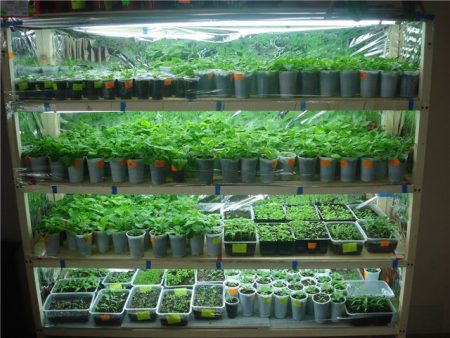
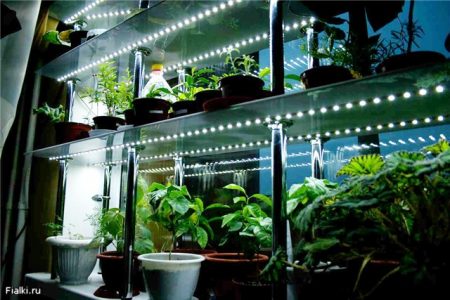
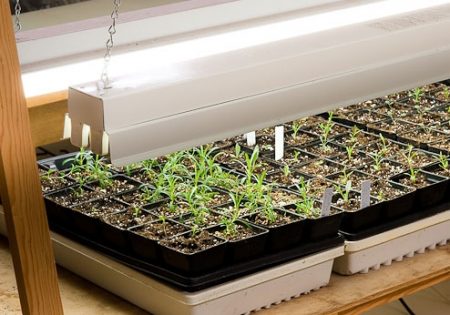

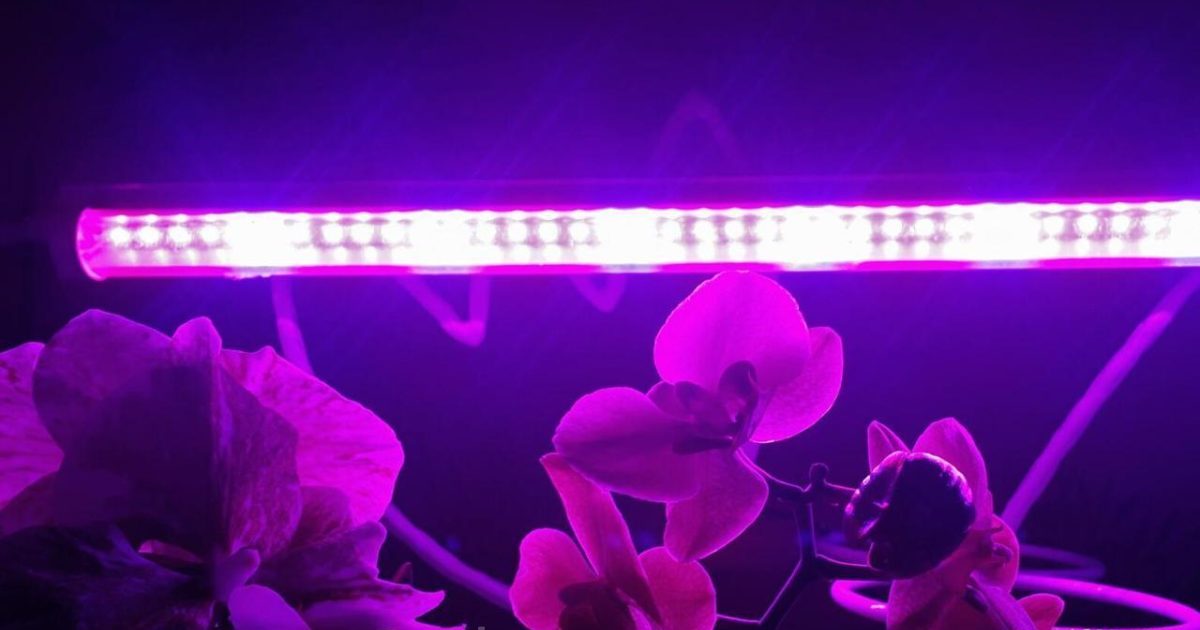
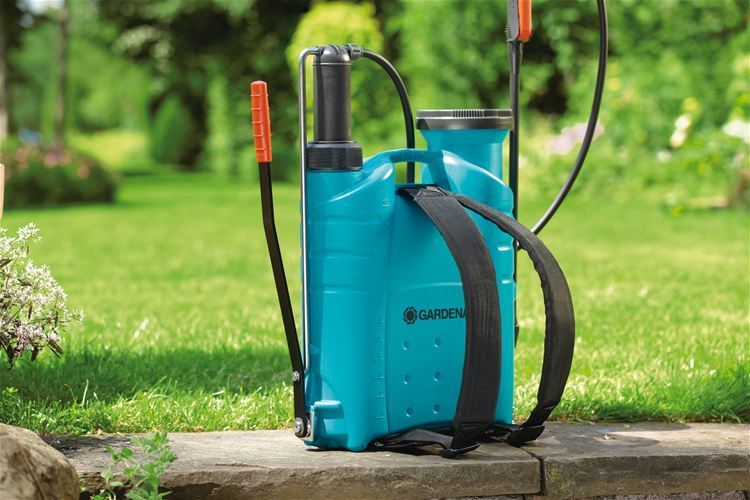
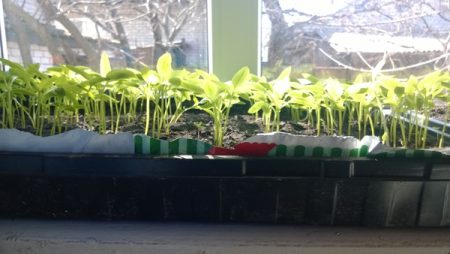
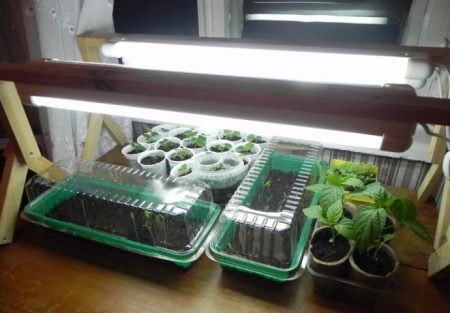
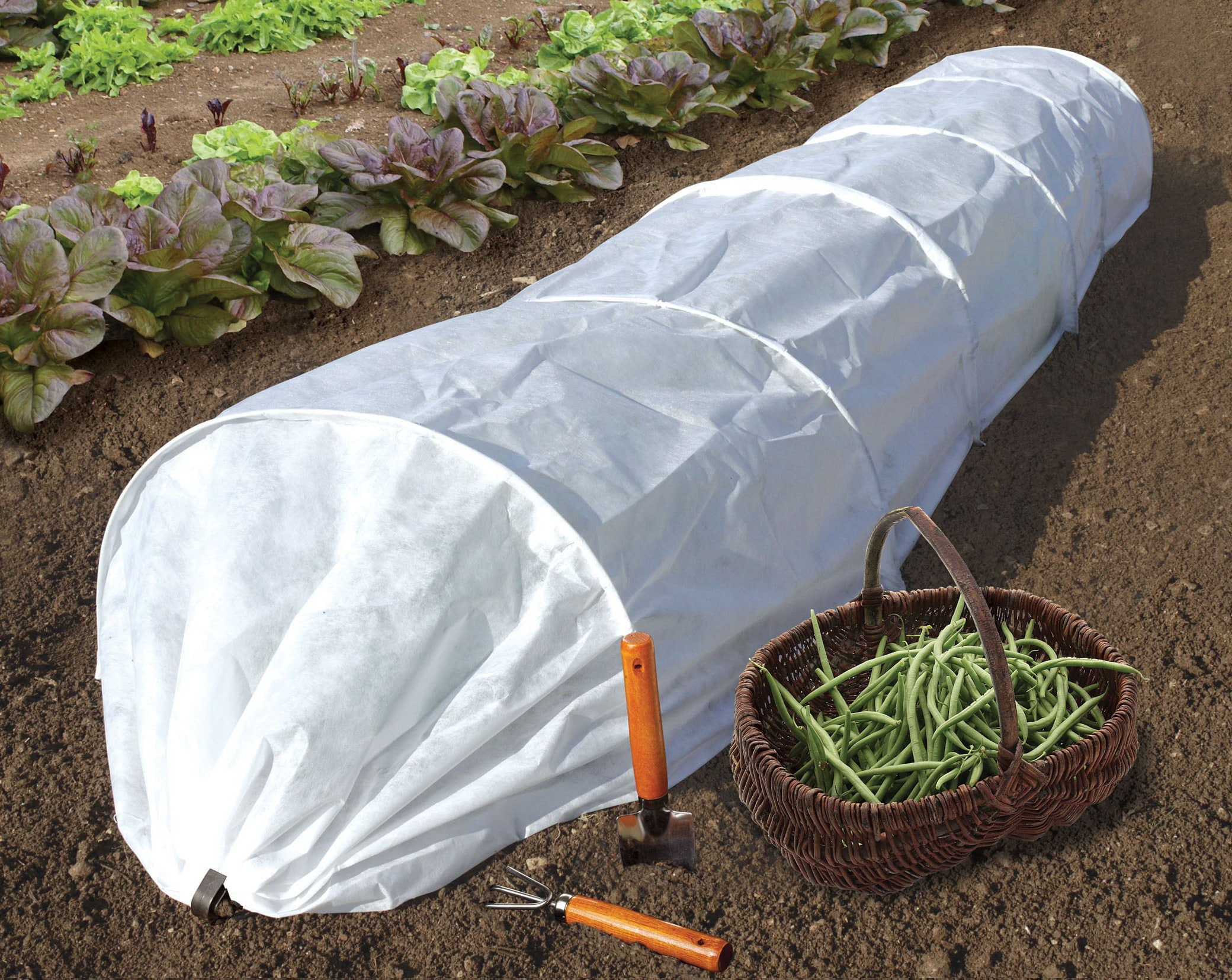 Cover material for plant care: features of use
Cover material for plant care: features of use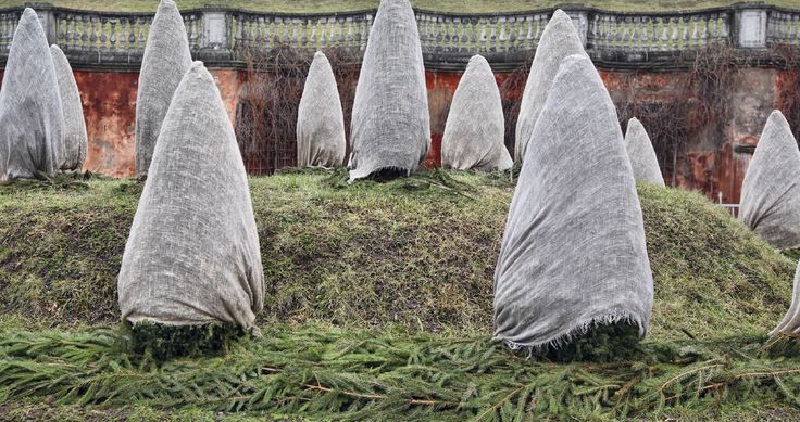 Types of winter covering material for plants
Types of winter covering material for plants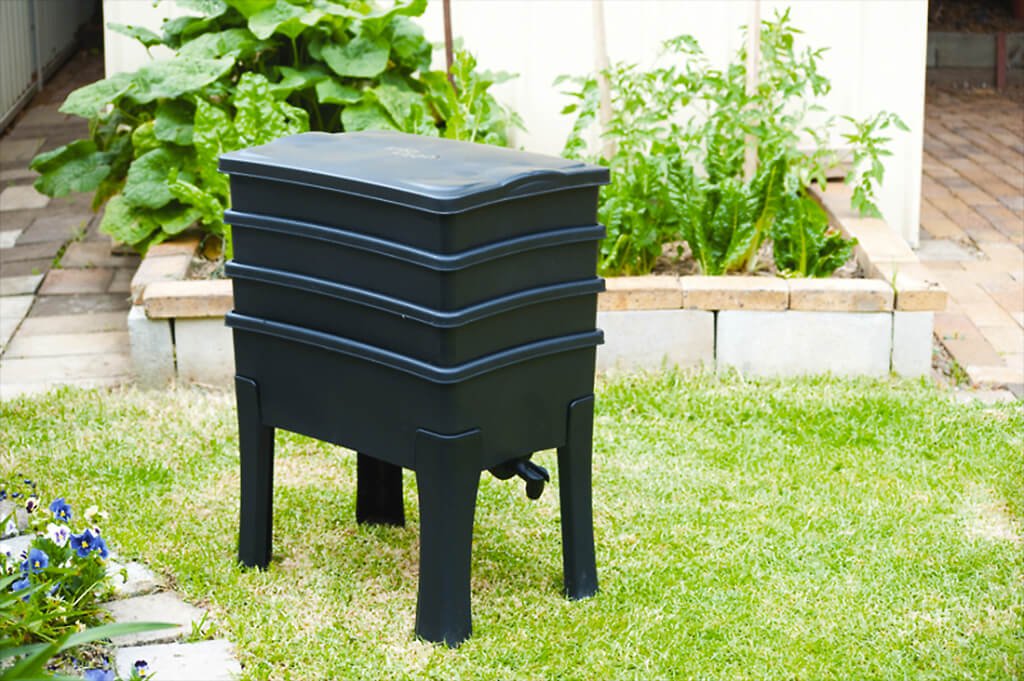 Biohumus Farm
Biohumus Farm What covering material to choose for a greenhouse?
What covering material to choose for a greenhouse?
Igor Ivanovich
Apartment garden
Many gardeners at the end of the season the question arises of what to do with plants that still bloom and bear fruit in the beds. Look at the photo - cherry tomatoes, they still have to grow and grow. Throw out such a miracle, the hand does not rise. So I, faced with such a problem, became thoughtful.
So, what are the basic conditions for growing plants? Of course, this is a constant positive temperature, sufficient and cyclical lighting, as well as suitable soil and moisture. Living conditions in a city apartment already provide a constant positive temperature. It remains to provide sufficient illumination, quality soil, regular watering, and of course, to allocate space with air access.
My first experience in gardening was related to growing seedlings in an apartment in the middle of winter (see photo below). It is clearly seen that the problem with lighting was then solved with a simple daylight lamp. I am sure that this method is not for many "open secret" for many.
Outside the window is February, and seedlings of tomatoes and peppers are developing, however, due to the lack of light from a simple lamp and the lack of the necessary spectral range, it is very elongated.
It was then that I had the idea to make a bookcase of small dimensions, with the necessary lighting, so that it took up little space in the room and did not spoil the interior. The first implemented design solution was a rack of wooden bars with four compartments, the walls of which are made of corrugated cardboard, glued with foil from the inside. The dimensions of the rack are 200x60x40 cm.
Next, it was necessary to organize the "right" lighting. I found LED sources for plants with the necessary spectral range of 380-840 nm.
As was written in the annotation, the light of these diodes has an ideal spectral composition for plants. The phosphor emits about 17% of the light of the blue spectrum and about 65% of the light of the red spectrum, 10% of yellow-green, the rest is IR and UV radiation. The innovative structure of the LED makes it possible to obtain radiation containing rays of the same spectrum as the sun, but in an optimal combination for plants. The light of blue and red light stimulates the growth of green parts of the plant, their flowering and fruit formation, the UV spectrum is needed for growing essential oil crops, and IR radiation promotes photosynthesis. This technology can be used for any type of plant, including seedlings.
Now it was necessary to make the lamp itself. After some time and having gone through all the design torment, I got two models. One is a block of three light sources, the other is a single, "point" light source. In the photo everything is clearly presented.
I installed a bookcase, or as it is commonly called, “phyto box” (in the English version “grow box” - a growing box worth a lot of money) I installed in the corner of the living room, next to the interior door in the far window, so that the lighting I only got artificial. In order not to go broke on electricity, I set a network timer, which turns on only at night (the time of the minimum tariff for electricity). In addition to saving, the timer provides a day-night cycle. A photo of the timer is presented below.
The first results of my efforts became visible in the fall-winter-spring of 2015-2016. These were plants of tomato, pepper, cucumber, lettuce, parsley. Everything is presented in the photo.
But in the photo on the left is the same “cherry” tomato that remained after the end of the summer season and had a wonderful winter stay.
And in these photos, two cucumber plants grow on the right, there was an idea to try to grow them to fruits. But, apparently, the variety was not completely “that”. No, the cucumbers bloomed, but the color was only “masculine”, the ovaries did not appear, and there were no fruits. Later, in the spring, I brought them to the cottage and landed them in a greenhouse, tried to "reanimate", but there was practically no harvest. But the peppers in this “phyto box”, under the LED lighting, really liked to grow. Big and strong were the plants. (A flowering cucumber is visible on the left.)
In the photo: in the left drawers - parsley and salad. It has not yet been possible to grow them to “full condition” - probably for them the illumination is low, and the peppers are quite happy.
With such results, I came to the spring-summer season of 2016. And in the autumn-winter-spring period of 2016-17, there was an idea to grow strawberries in the same conditions and get at least some kind of crop. In addition, the goal was to continue the experiment on growing cucumbers, taking into account already gained experience. For cucumbers, I made a new phyto box of a somewhat simplified design.
And now the results of the experiment began to appear. These are the first flowers and berries of strawberries. What a blessing, because it turns out!
And this is already, you can say the harvest. He treated his wife, son and grandson, and even one of the guests. Praised, said sweet. And what a smell in the room, and it's all in the winter! Well, complete happiness for the gardener - a pensioner at 77 years old. You can live on, years are not a hindrance!
In parallel, he continued to research the results obtained using various lighting. The photo below shows a spotlight with an increased power of 3 watts. The question arose, and what kind of lighting give my lamps. It is very important. I had to read a little about the theory of light and buy a light meter for measurements. The results are not bad, and the main design of the fixtures allows you to place them in any position - from above, left, right, bottom. As the plants grow, they can be raised to the desired distance. It is important that these lamps practically do not heat up (as provided by the design), which means that they can be placed close to the leaves.
I wanted to write a few more words about cucumbers, but better look at the photo, everything will be clear from them.
Soon I will treat my family. The variety of cucumbers is "urban, precocious."
In conclusion, I want to devote a couple of lines to another product developed and made by me. This is an electric skirting board. Key Features: shown in the photo. . I also “attached” him to my “gardening”, and sometimes I use it to heat plants in a greenhouse in the cold season. Together with the thermostat "Hot baseboard" turns into an effective heating system for the living room.
In conclusion, I want to say what is important to me.Like any creative person, a design engineer, I would like my products to be in demand by interested people and be useful. I can produce my electric heaters, phyto boxes and plant lights according to your orders.
If my story interests you, do not find it hard - share it with family, friends and acquaintances. I beg you very much.
Sincerely, Igor T.